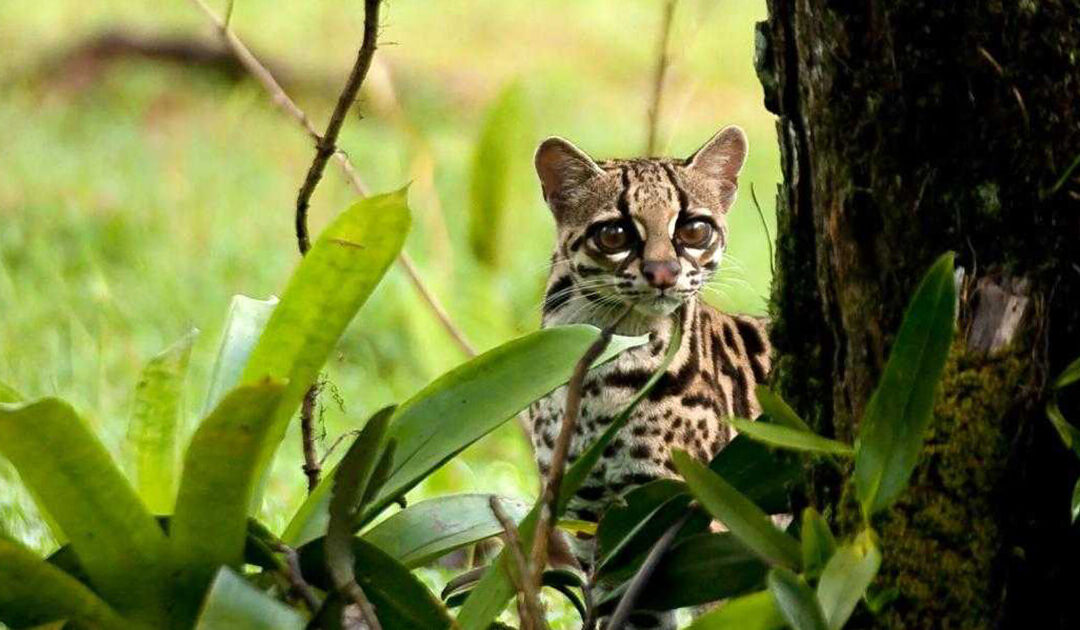Many tourists have heard about the world famous bird watching in Costa Rica, but there is also another type of animal that is worth your attention: wild cats. Costa Rica is actually home to six different wild species: Ocelot, Margay, Jaguar, Puma, Jaguarundi, and Oncilla. Below are some cat facts for you to know when planning your next adventure vacation to Costa Rica.
Ocelot
The ocelot (Leopardus pardalis) is primarily found in the forests throughout Costa Rica. Being relatively large for a cat, the spotted feline is only out grown by the Jaguar and Puma. It has large paws which have granted it the Spanish name mano gordo (fat hand). These “fat hands” allow for the cat to swiftly climb trees and cross streams with ease. The base color of its coat can be grayish to cinnamon, with black spots that form streaks on the neck or elongated spots on the body. Its tail is marked with incomplete bands. Each individual has a unique coat pattern. In the past, ocelots have been devastated by the fur traders. In the 80’s, 130,000+ pelts were sent to the United States alone. It is illegal to import spotted furs now, but it now faces habitat destruction as most of the Costa Rican cats do. The ocelot hunts prey from small rodents to iguanas and peccaries. This cat is very secretive and is not usually seen. These beautiful cats are nocturnal and sleep in trees during the day. Keep your eyes on the trees and you may see one!
Margay
A much smaller spotted cat is the margay (Leopardus wiedii). Only slightly bigger than a domestic cat, the margay looks quite similar to the ocelot. The margay and ocelot are different from other Neotropical cats in that the hair on the back of the head and nape slants forward. These two cats have open spots outlined in black, but on the sides of the ocelot, these spots form bands. Occasionally there will also be a black margay. However, unlike its bigger cousin, the margay is strictly arboreal and can spend its entire life in the trees hunting monkeys and other tree-dwelling mammals. The margay likes the thick forests up to and above 3,000 meters in elevation. Margays are equally comfortable on the ground and are able to leap an incredible eight feet vertically and 12 feet horizontally – a helpful tool for catching prey. It has been recently discovered that the margay employs an unusual hunting technique of imitating its prey’s vocalizations. They prey on monkeys, rodents, lizards, and insects. Sometimes they will even raid chicken coops. Along with all of the previous cats, the margay is endangered because of deforestation. The margays do not survive well in disturbed areas that show signs of habitat loss. Perhaps watching groups of feeding monkeys early in the morning would be the best strategy for spotting a margay. Another locally focused place to visit is the Arenal Observatory Lodge where the Margays like to frequent the surrounding area.
Jaguar
From the Native American word “yaguar,” meaning “pouncing killer,” jaguars are the only Panthera species found in the Americas. The Jaguar is Costa Rica’s only “big cat.” It can grow to over two meters in length and weigh up to 250 pounds. They are a very threatened species due to habitat loss and illegal hunting. The Jaguar is primarily found in reserves and national parks where they are more protected. The female’s territory ranges from 2,500-9,000 acres and males can have up to 95,000 acres. Chances of seeing a male jaguar are slim. In Costa Rica, common prey includes green iguanas, sloths, peccaries, sea turtles, tapirs, agoutis, deer, boa constrictors, and monkeys. This “pouncing killer” gets its name by just that: stalking its prey then pouncing on the unfortunate meal and breaking its neck. You can keep your eyes peeled, but you probably would never know if one was close.
Puma
The Mountain Lion is known by many names: Puma, Cougar, catamount, and panther. They are almost as large as the jaguar and are one of the two Costa Rican cats that do not have spotted coats. Like other cougars, it is amazingly fast and can maneuver quite easily and skillfully. Even though conservation efforts of the Costa Rican Cougar have decreased against the “more appealing” jaguar, it is hunted less frequently because it has no spots, and is less desirable to hunters. The puma can overlap with the jaguar in range and territory, but the larger jaguar is usually dominant to the puma, and the puma accordingly adjusts its placement to avoid contact with its cousin. In some places, the puma has a misallocated reputation for being dangerous to humans, but only 44 fatal attacks have been recorded in the last 100 years. Some of the National Parks in Costa Rica that are home to these pumas are Corcovado National Park, Santa Rosa Park, Monteverde Cloud Forest Reserve. They may also be found in Cerro de la Muerte.
Jaguarundi
Perhaps one of the country’s most unusual felines is the Jaguarundi (Puma yagouaroundi). A relative of puma, it has an elongated body with short legs. Along with the shorts legs and unspotted coat, the Jauguarundi resembles a weasel more than a cat. It prefers to make its home around running water. Its diet consists of reptiles, rats, mice, ground birds, fish, frogs, and other small mammals. These cats are very territorial so many fights occur between them. Against popular belief that these felines are abundant throughout Costa Rica, they are actually on the decline due to deforestation. The Jaguarundi is the only wild cat in Costa Rica that is primarily active during the day and since it is reportedly well adjusted to human habitats, there is a reasonable chance of spotting it during our travels across the country!
Oncilla
The oncilla (Leopardus tigrinus) is the smallest of Costa Rica’s wild cats. It lives primarily at higher elevations, in montane forests on the flanks of volcanos and other high mountains. It is primarily nocturnal, but in areas where it preys mainly on diurnal lizards, the oncilla is more likely to be active during the day. It is very shy and solitary, but because its tracks are almost identical to a domestic cat’s, it can go rather anonymously about its hunting if humans live in the area. The oncilla mostly preys on birds and small rodents. It is usually a pale color with closed black spots and two pairs of strong black strips on the sides of the neck. Could you tell if it was a house cat or an oncilla?
About the Author Austin Adventures
Nestled just east of the Rocky Mountains in Billings, Montana, we have shared our love of adventure with our guests since 1974. Our insider’s knowledge and key contacts in each destination allow us to offer unique experiences and encounters that give our guests an in-depth feel for the local people and their way of life. Our trips are designed to deliver surprising luxury with an absence of pretension. We’ve done our research and know the best accommodations in each region. Austin Adventures considers every guest to be a VIP and regardless of destination, always aims to deliver on your high standards for luxury, quality, and comfort.

